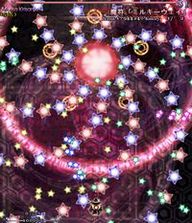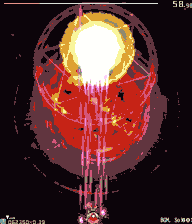Mechanics covers how a player controls the game and what their objectives are. In a platform game, it concerns things like the acceleration of the player character and how gravity affects them, or how a stage is beaten (usually "reach the end"). In a multiplayer real-time strategy game, it can cover things like unit selection and control, resource management, how technology trees work, and victory conditions (destroy all of an opponent's buildings, eliminate their army, kill their commander etc.) The mechanics essentially dictate a game's genre, and their level of refinement defines how pleasing it is to play on a basic, ergonomic level (compare Cheetahmen to Super Mario World). I would label this the "primary" of the three categories: any changes to the mechanics will usually necessitate changes to the levels or avatars. In general, the better a game's mechanics, the more depth it has.
The second aspect is level design. The world "level" here is used as a catch-all term for the arena or arenas in which the game takes place. Its significance is obvious in the context of, say, platform games, but I also use it here to refer to, say, maps in a strategy game, or raid dungeons in an MMO. Some games don't have different levels. Street Fighter II, for example, has different stages on which one can fight, but the differences are strictly cosmetic: they are functionally identical (Vega's stage being the one exception). Levels can be created in a modular fashion after a game is "finished" without any changes to the mechanics. This can take the form of mission packs for an RTS, fan-made hacks for platform games, and so-on. Generally speaking, the number of levels available in a game defines its length.
The third aspect could be called either character design or avatar design. The first sounds a bit less stuffy, but is not as precise, as it suggests a visual design component. This concerns the controllable characters available to a player. Many games have only one avatar. The first Sonic and Mario games are good examples. Later installments of both series introduced more options. Avatars are a core aspect of many competitive genres, such as fighting games. In a real-time strategy game like Starcraft, I would consider a race, rather than a single unit, to be an avatar (races and units are analogous to characters and their moves in a fighting game). As with levels, it is possible to add avatars after a game is released (this was largely the motivation for Ultimate Marvel vs Capcom 3, for example). Speaking loosely, the more avatars a game has, the more breadth it can be said to offer.
These three aspects can be defined seperately but they are inextricably linked. The levels can only make sense within the context of the mechanics, and must be accessible for the avatars, the avatars must have abilities that give them options within the levels, and so on. Sonic 3 & Knuckles is a great showcase of the necessary synergy between characters, levels, and mechanics. Playing the game as Sonic, one can see a certain amount of every level, but upon trying out Tails or Knuckles it becomes apparent that there are parts of many stages that only they can access. Knuckles can climb walls to reach higher areas that Sonic can't get to, and can smash down certain walls that are impenetrable to other characters. However, his jump is subtley lower, and since he can't climb on spikes and certain other surfaces there are still places he can't go that Sonic can.
 |
| Knuckles cannot climb on these platforms, and, unlike Sonic, his jump is too low to get on top of them. |
 |
| However, there is a secret wall here that only Knuckles can break down. |
Tails, however, can only fly for so long at a time before tiring out, whereas Knuckles can climb infinitely given grippable surfaces. Thus, there is a tall vertical shaft at the start of Sandopolis Act II that only he can traverse.
 |
| Knuckles can get all the way up here no problem. |
 |
| But Tails can only get this far before running out of steam. |
On top of this, one of the game's secondary objectives, the Chaos Emeralds, favours Sonic. Upon collecting all of them, every character can make use of a more powerful "Super" form. And in short, Sonic's is the best. Super Sonic's acceleration, top speed, and jump height are far superior to those of Super Knuckles and Super Tails. It even affords him access to a whole level that neither other character can enter, the climactic Doomsday Zone.
Thus, the game's three avatars offer truly different options for a player, and reward different styles of play. Compare this to Sonic Advance. In this there are 4 characters available, the familiar trio plus Amy Rose, who uses a squeaky hammer as a weapon and pole vault for higher jumps. However, the stages do not offer any interesting alternative paths or secrets for any character. There's the odd shortcut one can make, but they seem to be accidental rather than intentionally designed. There's essentially no part of a level that can't be accessed by every character. In short, it feels like the levels were designed around Sonic, and then the alternative avatars were added as an afterthought. The mechanics are still solid (the physics are pretty faithfully copied from the Mega Drive games), but the level design fails to take advantage of the avatars offered.
This framework offers some perspective on Starcraft, a game whose design has possibly undergone more scrutiny than any other's, especially in relation to its successor, Starcraft II. The former is highly revered by almost anybody with a general interest in competitive games, and while the latter has gained some coverage, if you ask somebody familiar with both as to its actual competitive quality you will usually get a lukewarm response. You can find complaints fitting into all three of the categories I've suggested. In mechanics, one can look at things like "deathball syndrome" that is ironically caused by a pathing algorithm that is too good.
 |
| Deep, tactical combat. |
Or the economic tools that often seem to balance a race on the razor edge of unplayably underpowered or gamebreakingly overpowered.
For level, or map, design, there are the destructible rocks that many felt were a dull gimmick to delay base expansion possibilities, or the high-yield gold minerals that had apparently broken synergy with Terran's high-yield mining tool, the Mule, (until their interaction was patched) not to mention the long transitional period from Blizzard's tiny maps that resulted in games that were too short, to huge league created maps that went to the other extreme and created dull stalemates. And for race/unit design, there are the Terran Marauder and the Zerg Roach, which feel against the core design principles of their own races, resembling Protoss units more than anything else, or the Protoss Colossus and Sentry, which only seem to reduce possibilities for good tactics and control.
 |
| Welp, guess the Protoss wins this fight. Again. |
The relation to my previous major post is probably clear by now. I wrote a bit about the mechanics of scrolling shooters as a whole, and then focused on the level design in the Touhou games. I could also talk about the avatar design in these games, since for a long time they have offered a selection of characters with different shot types, bombs, and other gimmicks, and they do expose a few clever design traits in some installments. However, it's not what I feel is the strongest aspect of this series, so it's not what I focused on.
I hope some of that was interesting. Nothing I've written here is really new, but I think it's a neat way to categorise ideas. Also I'm sorry that alot of my examples are probably impenetrable to those not familiar with the games I'm talking about, but the only way to avert that would be to make this post way too long. If nothing else, I hope this provided some food for thought.
In other news, here's a drawing.
It's our party from the Pathfinder campaign I'm currently playing! From left-to-right-top-to-bottom: Pan, Catherine's human rogue/ranger, a little urchin who's already got us into trouble with her unchecked thievery; Robomir, Sam's human fighter, Pan's uncle, generally trying to safeguard his niece's supposed innocence; Jammy Dodger, Blanca's gnome summoner/alchemist (or jamchemist), plus her eidolon, the marmalooze, she specialises in chilli bombs, handbag slinging, and mage-hand hair-pulling; Dorfbram Boozelmite, my dwarf-revering gnome barbarian/boozehound (for the record, there is no good reason to ever play a gnome barbarian); Slok, Joe's half-orc druid, specifically frogwarden, who we thought was going to be overpowered but whose squadron of giant frogs have turned out to be largely a liability (R.I.P. Kruk). It's really hard to make such different characters mesh in an image. Especially when people have such disparate colour sensibilities. My progress on this drawing was essentially logarithmic, and even looking at it now I can see more stuff I want to try tweaking, but I should stop here for the sake of my own sanity.











































